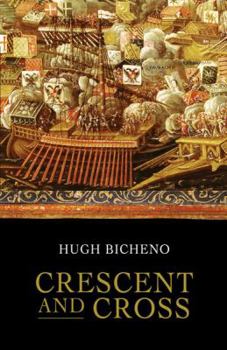Crescent and Cross: The Battle of Lepanto 1571
Select Format
Select Condition 
Book Overview
"Unlikely to be surpassed."--"Literary Review" Here is the first major history in decades--and the first-ever original study in English--off an epic encounter between the Christian and Islamic worlds.... This description may be from another edition of this product.
Format:Paperback
Language:English
ISBN:1842127535
ISBN13:9781842127537
Release Date:March 2005
Publisher:Phoenix
Length:320 Pages
Weight:0.70 lbs.
Dimensions:0.9" x 5.2" x 7.7"
Customer Reviews
3 ratings
Impressive history but a difficult read
Published by Thriftbooks.com User , 17 years ago
The narrative of this thorough and extensive work is divided in two: Iconic Battle and Military Battle. The first section deals with the Mediterranean in the 16th century (The Stage), ships and weapons (The Props), the empires, states, peoples and leaders of the time (The Players), international politics and role of the Catholic Church in the formation of the Holy League (Billboard). Part Two looks at the immediate background (Scene Setters), the campaign of 1570, the Ottoman offensive of 1571, the Holy League response and the details of the battle, concluding with an epilogue. The book opens with a Chronology of rulers from 1500 to 1600 and important events from 1492 to 1600. Eight pages of colour plates include, inter alia, portraits of Don John, Sultan Selim II, Pius V, and various battle scenes by artists like Vasari, Vicentino, Veronese, Titian, Sebastian de Caster and Juan Luna. The 8 pages of black and white plates include the flagships of Ali Pasha, Don John Of Austria, various types of armor and weaponry, papal galleys and some battle scenes. In addition, there are three diagrams in the text: a depiction of a Venetian light galley, fortification systems and the decorative stern of Don Juan's galley La Real. Thirteen excellent maps enhance the text, focusing on relevant parts of the Mediterranean and Adriatic, on the Ottoman expansion into Europe, Africa and Asia, the 1570 and 1571 campaigns, the battle site at Navpaktos at the mouth of the Gulf of Corinth, the deployment of ships and different stages of the battle. The vast scope of the book encompasses discussions of culture, religion and representations of the famous clash in Christian art and iconography. Bicheno deals extensively with the myth and the legend in literature by discussing and quoting works by Cervantes, Felix Lope de Vega y Carpio, Luis Velez de Guevara, Shakespeare (Othello), Thomas Moravius, Fernando de Herrera, Alonso de Ercilla y Zuniga and of course GK Chesterton and his magnificent poem Lepanto. The account of the battle itself is quite detailed as Bicheno draws on all available sources (whilst evaluating them) to analyse the vessels, the weaponry, the tactics, the terrible carnage and the liberation of the Christian slaves. The author is highly critical of Europe and the fractious Christendom of the time in his introduction. He compares the world of the 16th century with our own time and is a Eurosceptic (good) but a bit too repetitive in his assertions of the supposed tolerance and civilizational superiority of the Ottoman Empire against the supposed backwardness of Europe (bad). Bicheno insists time and again that the battle had no major military significance and that the Catholic Church largely nurtured the legend of the great Christian victory. In this, he does not fully convince. Yes, the Turks immediately rebuilt their navy but it was done in great haste to produce a ramshackle fleet that never again threatened the West. What makes the writing difficul
A lively but deeply researched history
Published by Thriftbooks.com User , 20 years ago
This is far more than a history of a particular battle. Bicheno devotes the first 248 pages of his book to setting the political and military stage, including previous conflicts between European Christians and Ottoman Turks. The actual clash of fleets at Lepanto takes up less than thirty pages. Nonetheless, this book is a lively read. Bicheno has ranged widely in his research, touching on everything from religious attitudes to fortress design. And he knows how to tell a story, or in this case many stories. The book includes color and black and white plates, plus some diagrams. Three appendices provide details.
Hugh Bicheno is a new and rising talent
Published by Thriftbooks.com User , 20 years ago
I want to correct the inaccurate view given by the reader from Venice. This book is not written by an amateur, but by a gifted historian who has been receiving widespread acclaim in Europe. He is one of the authors of the Oxford Companion to Military History. Britain's "Sunday Telegraph", probably the most conservative of the national newspapers, claims that Bicheno "has all the right qualifications", and that this is "a wide-ranging and constantly engaging book, written under the pressure of real intellectual enthusiasm". Normam Stone, historian, reviewer and Professor of International Relations in Turkey, says that "if you wish to have a very readable and knowledgeable account of the many sides to [this sixtenth century world], Hugh Bicheno's book is the right start".I openly confess that I am the publisher of this book, and perhaps you should take the five stars I have given it with a pinch of salt. On the other hand, I would urge you to pay attention to the alternative reviews I offer above, from people who know what they are talking about. I don't make a habit of reviewing the books I publish - if they get a bad review from a reader I tend to shrug my shoulders. But I am passionate about this particular book, and am frustrated to find it so badly misrepresented. My answer to the reviewer from Venice: Hugh Bicheno is not an amateur, and perhaps you should leave the reviewing to the professionals!




